Regional Currencies of the Bara Kusini
Mzigo - the Currency of the Northern Mchanga Hasira
Minting Authority:
Minted by individual bank jewelers in the city-state of Il-Wāāt ul'Ihāt Kathira using prescribed weights - leading to variations in design.
![tychodreq_a_stone_table_littered_with_strings_of_medium_sized_t_fa6f68d4-e8df-4b20-827c-a4022c875767[1].png](/application/files/2816/9110/1453/tychodreq_a_stone_table_littered_with_strings_of_medium_sized_t_fa6f68d4-e8df-4b20-827c-a4022c8757671.png) In the vibrant and culturally rich lands of the Northern Mchanga Hasira, the currency is not merely a medium of exchange but a symbol of heritage, artistry, and societal values. Known as Mzigo, this unique currency system intertwines economics with aesthetics, tradition with innovation.
In the vibrant and culturally rich lands of the Northern Mchanga Hasira, the currency is not merely a medium of exchange but a symbol of heritage, artistry, and societal values. Known as Mzigo, this unique currency system intertwines economics with aesthetics, tradition with innovation.
The Mzigo is composed of meticulously crafted tube beads, each a masterpiece in its own right. Made from precious and semi-precious metals such as copper, silver, gold, and a rare form of black platinum, these beads are more than just currency; they are wearable art, a tangible connection to the region's history and identity.
The system is rooted in the sexagesimal numeral base, reflecting the mathematical sophistication of the Northern Mchanga Hasira. This structure allows for a seamless integration of commerce, trade, and daily life, with denominations that are both logical and beautiful.
Each bead, or Mzigo, carries its own value and significance. From the humble Takwa, made of copper, to the opulent Jewakwa, adorned with precious gemstones, the Mzigo represents a hierarchy of value and status. The designs vary between financial institutions, with jewelers crafting unique patterns and motifs, adding to the diversity and richness of the currency.
But the Mzigo is more than just a means of buying and selling. It's a celebration of craftsmanship, a testament to the region's skilled artisans who transform metal and stone into intricate beads. It's a reflection of the community's relationship with the natural world, drawing from the earth's bounty to create something both functional and beautiful.
In the Northern Mchanga Hasira, the Mzigo is not just currency; it's a way of life. It's a dance between economics and art, a melody of metal and gemstone, a story told through the hands of craftsmen and the pockets of traders. It's a system that speaks to the heart of a people, living under the watchful gaze of a crimson sun, thriving in a land where tradition and innovation walk hand in hand.
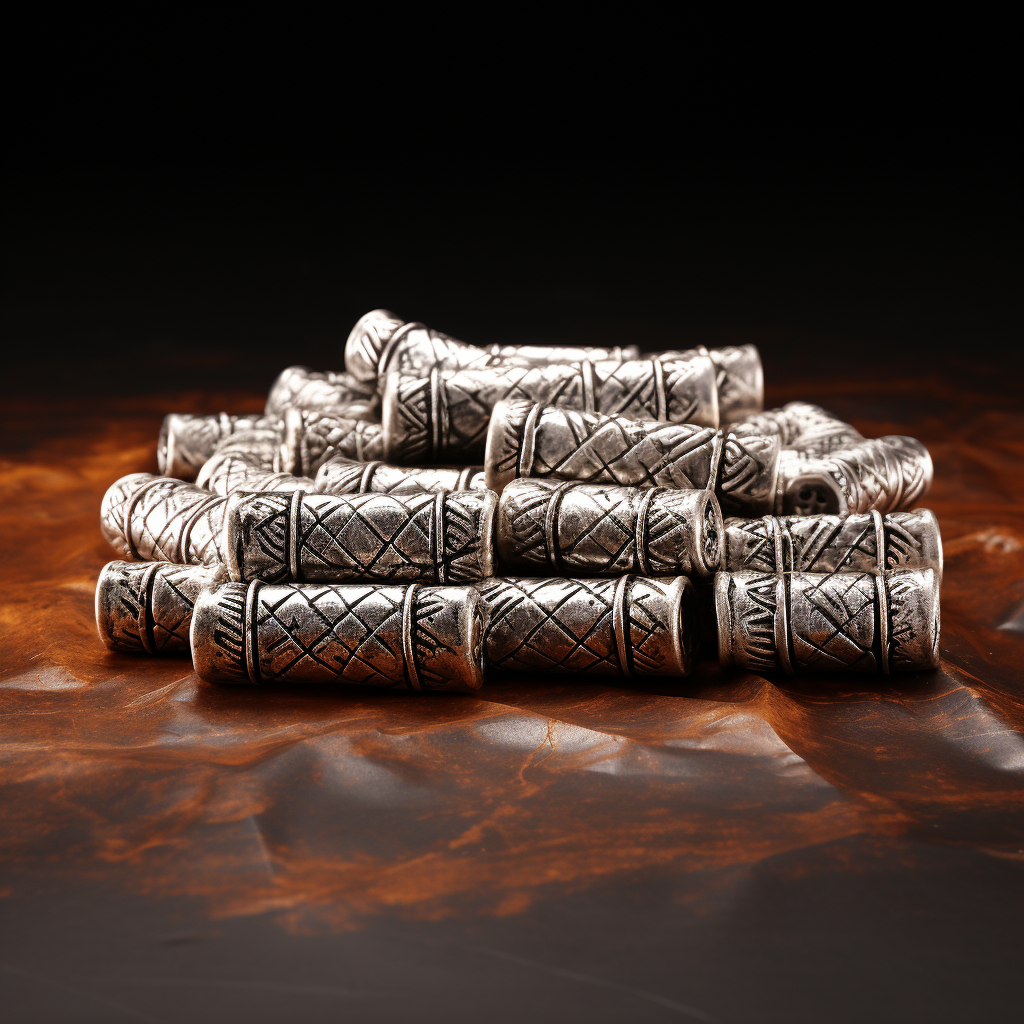
Silver Mzigo - "Sikara" - Made of silver, these hand crafted beads are worth 10 Takwa. They are used for more significant purchases and are a standard form of currency in daily trade.

Gold Mzigo, or 'Gawida,' the standard unit of currency in Northern Mchanga Hasira. Each handcrafted piece, whether cast, hammered, or formed from wrapped wire and tube, is a testament to artistry and innovation. Banks compete for skilled designers and artisans, making the jeweler trade for Mzigo creation both competitive and lucrative. In a land where value is fixed, it's the craftsmanship that sets them apart, symbolizing cultural pride and the fusion of economics and aesthetics.
Monetary System of the Northern Mchanga Hasira
1. Copper Mzigo - "Takwa"
- Value: 1/60th of a gold bead
- Description: These are the smallest denomination and are made of copper. They are often used for minor transactions and are a common form of currency among the general populace.
2. Silver Mzigo - "Sikara"
- Value: 1/6th of a gold mzigo
- Description: Made of silver, these beads are worth 10 Takwa. They are used for more significant purchases and are a standard form of currency in daily trade.
3. Gold Mzigo - "Gawida"
- Value: The base value Mzigo bead
- Description: The gold beads are the standard unit of currency and are used as a reference point for all other denominations. They are widely accepted and are often used in larger transactions.
4. Black Platinum Mzigo - "Plakara"
- Value: 60 gold beads (Gawida)
- Description: These rare and valuable beads are made from a unique black form of platinum. They are used for significant purchases and investments and are often considered a status symbol.
5. Gemstone Mzigo - "Jewakwa"
- Value: Varies, starting from 360 gold Mzigo beads
- Description: These ornate beads contain precious gemstones and are used for the largest transactions and as investments. The value can vary based on the rarity and quality of the gemstones used.
Monetary System Features
- Weight Standards: Though designs differ between financial institutions, there are strict weight standards across all currencies to maintain consistency in value.
- Artistic Variation: As the beads are made by jewelers working at different banks, there is a rich diversity in design. This artistic variation adds to the cultural significance of the currency.
- Wearable Currency: Mzigo beads are often worn as decoration, adding a unique aesthetic value to the currency. This wearable aspect can sometimes lead to variations in value between jewelers, depending on craftsmanship and design.
- Exchange and Trade: The Mzigo system facilitates trade and exchange within the society, with clear conversion rates between the different denominations. The sexagesimal base ensures that calculations and conversions are efficient.
- Cultural Significance: Mzigo is not just a medium of exchange but also a symbol of cultural identity, craftsmanship, and artistic expression.
Mizunguko and Sarafu - The Currency of Southern Mchanga Hasira
Minting Authority:
Minted by the State of Nephisis on the Riis ul'Nephis river system, ensuring standardized designs and values.
In the bustling and industrious lands of Southern Mchanga Hasira, currency is a reflection of unity, statecraft, and societal order. Known collectively as Mizunguko and Sarafu, this currency system embodies the region's commitment to standardized value, functionality, and state-controlled craftsmanship.
The central currency, Mizunguko, is a solid tube of silver, often referred to as "Mizun." Accompanying this are the Sarafu, medium-sized coins of copper and silver, threaded on "kamba za sarafu," ropes of coins, and worn off the belt. Even the golden Siku coins and the prestigious Mstatili wa Gawida gold bars play a vital role in the economic landscape.
Minted by the State of Nephisis on the Riis ul'Nephis river system, the Southern currency is a symbol of centralized authority and uniformity. Unlike the artisanal diversity of the North, the South's currency reflects a harmonized design, ensuring consistency and trust in the system.
Each denomination carries its unique purpose and value. From the copper Sarafu, known as "Chakopa," to the gold bars called "Mstatili wa Gawida," the currency represents a well-structured hierarchy. Even the kamba za sarafu, with their heavy bronze balls, "Fimbo ya Shaba," serve a dual purpose, acting as a makeshift weapon, reflecting a unique blend of practicality and cultural tradition.
But the Southern currency is more than just a tool for trade. It's a manifestation of state power, a testament to the region's ability to regulate and standardize value. It's a reflection of the community's relationship with governance, drawing from the state's authority to create something both functional and symbolic.
In Southern Mchanga Hasira, Mizunguko and Sarafu are not just currency; they are a way of order. They are a dance between statecraft and daily life, a melody of metal and governance, a story told through the minting halls of Nephisis and the markets of the land. It's a system that speaks to the heart of a people, living under the watchful gaze of a crimson sun, thriving in a land where unity and regulation walk hand in hand.
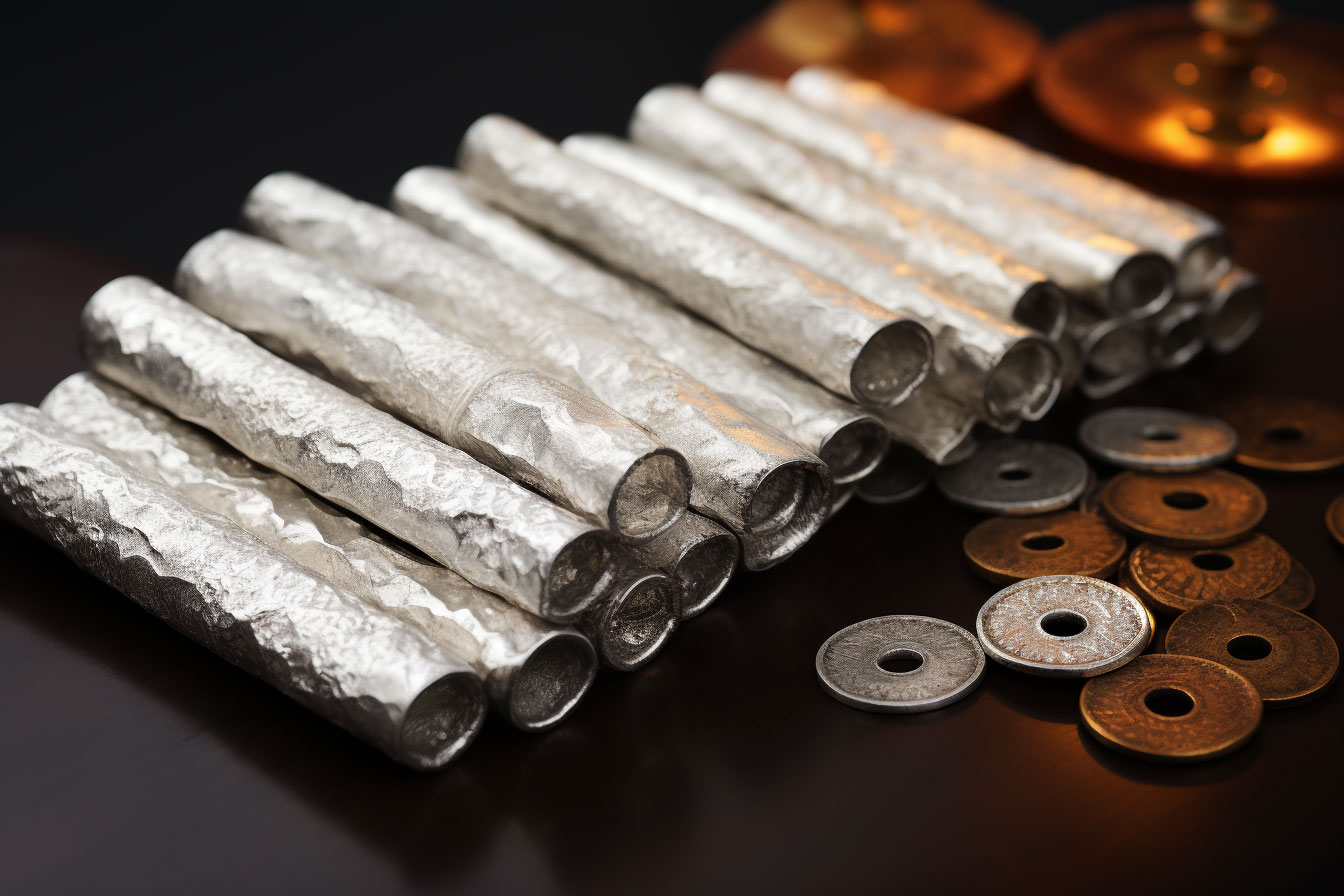
Silver Mizunguko, the central silver currency of Southern Mchanga Hasira, accompanied by Chakopa and Shabara Sarafu coins. While displayed here unthreaded and loose, Sarafu are normally organized on 'kamba za sarafu,' ropes of coins, and worn off the belt, reflecting a unique blend of practicality and cultural tradition.
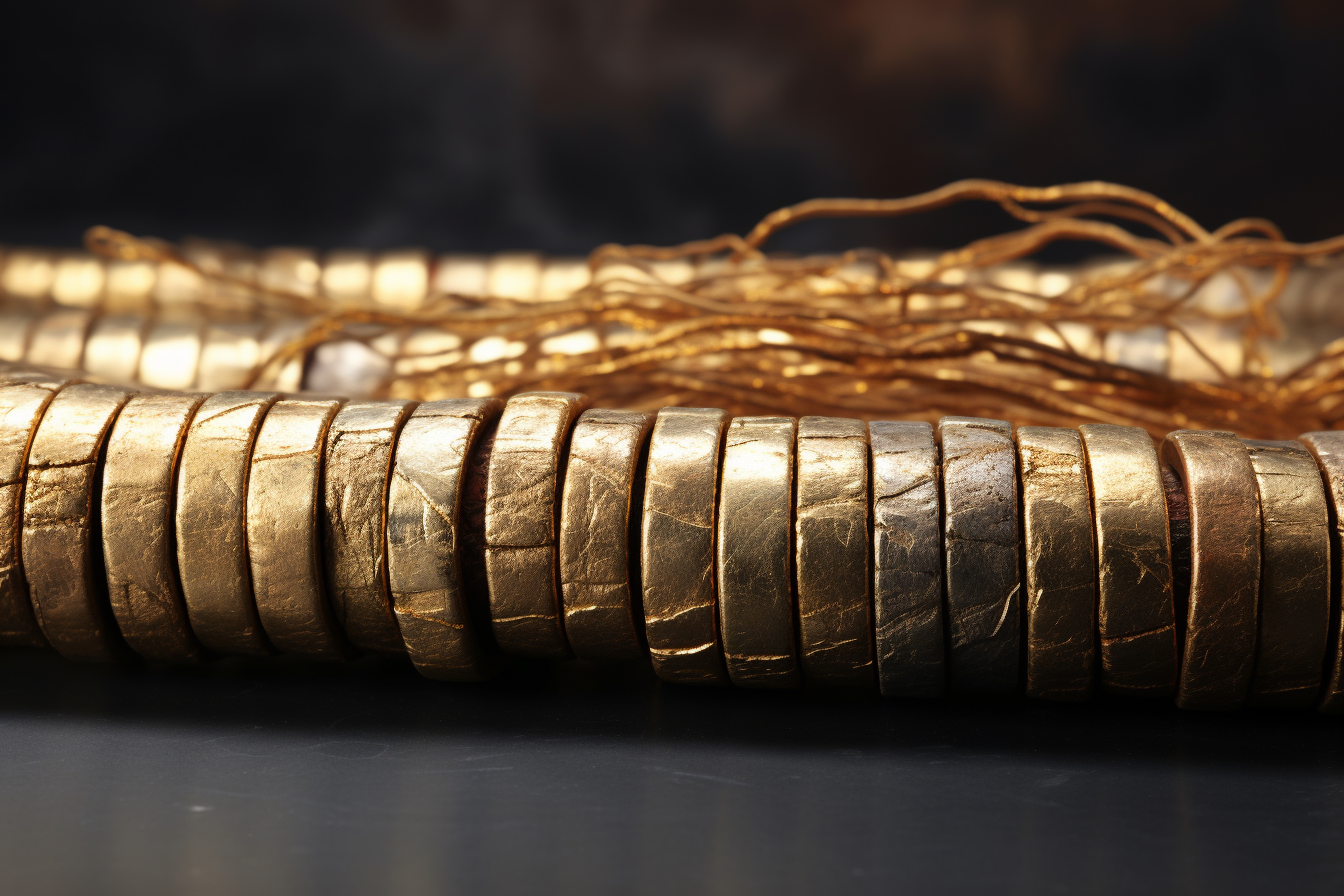
Gold Siku, threaded on a kamba za siku, a specialized rope for carrying these valuable coins. In Southern Mchanga Hasira, kamba za sarafu, especially when laden with golden Siku coins, serve a dual purpose. They are often tied with a heavy bronze ball, known in Kawaida as 'Fimbo ya Shaba,' which acts as a stop for the coins and transforms the kamba za sarafu into a makeshift weapon. This multifunctional design, allowing the rope to be drawn from the waist and swung in self-defense, reflects a unique intersection of economy, culture, and personal security.
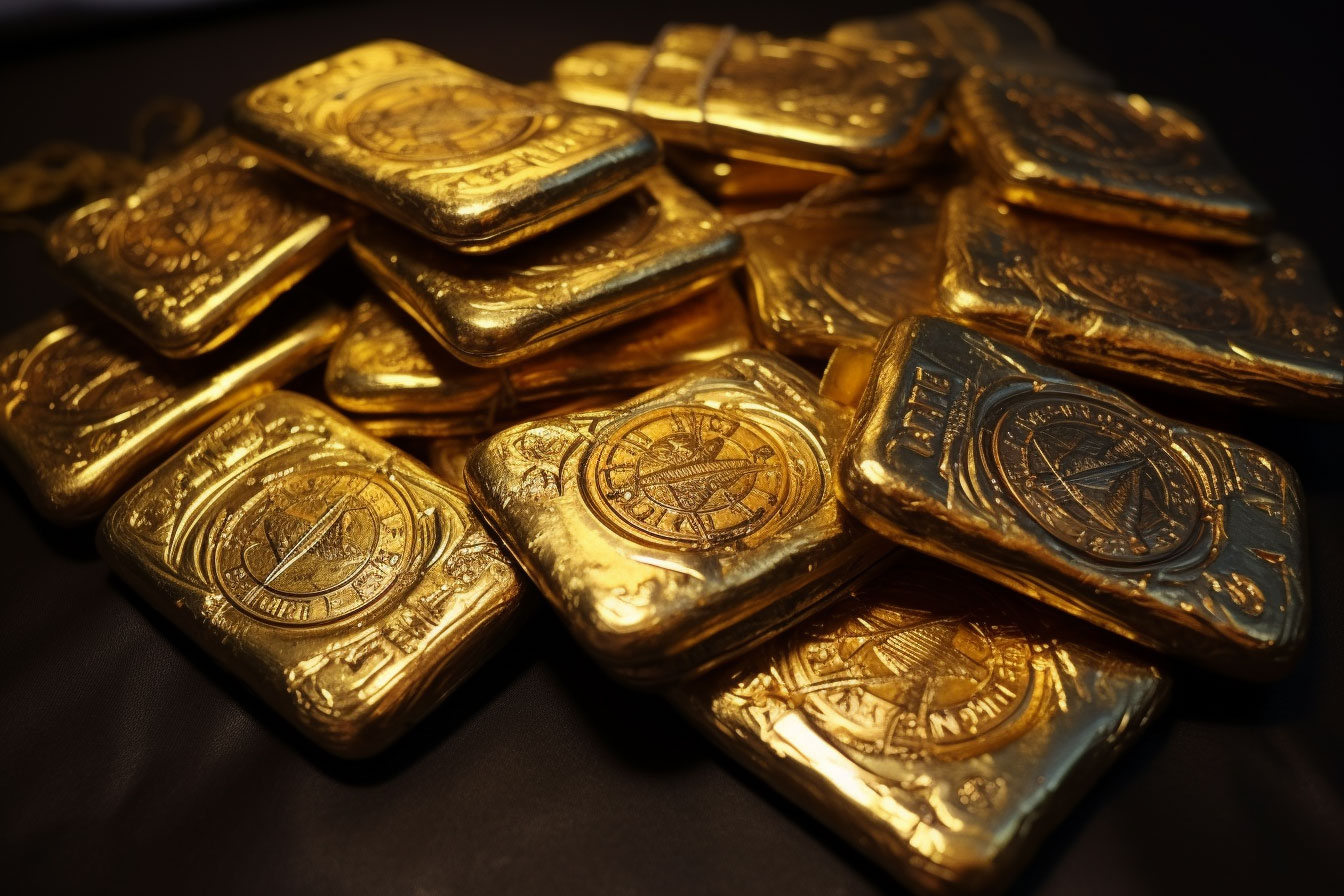
Mstatili wa Gawida, the prestigious stamped gold bars of Southern Mchanga Hasira. Reserved for the most substantial transactions, these gold bars are a symbol of wealth and power. Used in trade, the purchase of land, ships, or large governmental acquisitions, the Mstatili wa Gawida embodies the economic strength and cultural heritage of the region, reflecting a tradition of craftsmanship and a commitment to enduring value.
Everyday Currency:
-
Mizunguko (Mizun) - Central Currency
- Material: Silver
- Value: Standard unit of currency
- Description: A solid silver tube, often referred to as "Mizun." This is the central currency, used widely for various transactions.
-
Sarafu - Medium-Sized Coins
- Copper Sarafu - "Chakopa"
- Value: 1/120th of a Mizunguko
- Description: Copper coins with a central hole, used for minor transactions.
- Silver Sarafu - "Shabara"
- Value: 1/30th of a Mizunguko
- Description: Silver coins, similar to Chakopa but of higher value.
- Ropes of Coins: "Kamba za Sarafu" or "Kamba za Siku" see below - Organizational threads or chains for coins.
- Copper Sarafu - "Chakopa"
Larger Transaction Currency:
-
Siku - Gold Holed Coins
- Material: Gold
- Value: Equivalent to 30 Sarafu
- Description: Thick, stamped gold coins with a hole, reserved for trade and significant purchases.
-
Mstatili wa Gawida - Stamped Gold Bars
- Material: Gold
- Value: Equivalent to 360 Sarafu
- Description: Highly valuable gold bars used for substantial transactions such as land, ships, or governmental purchases.
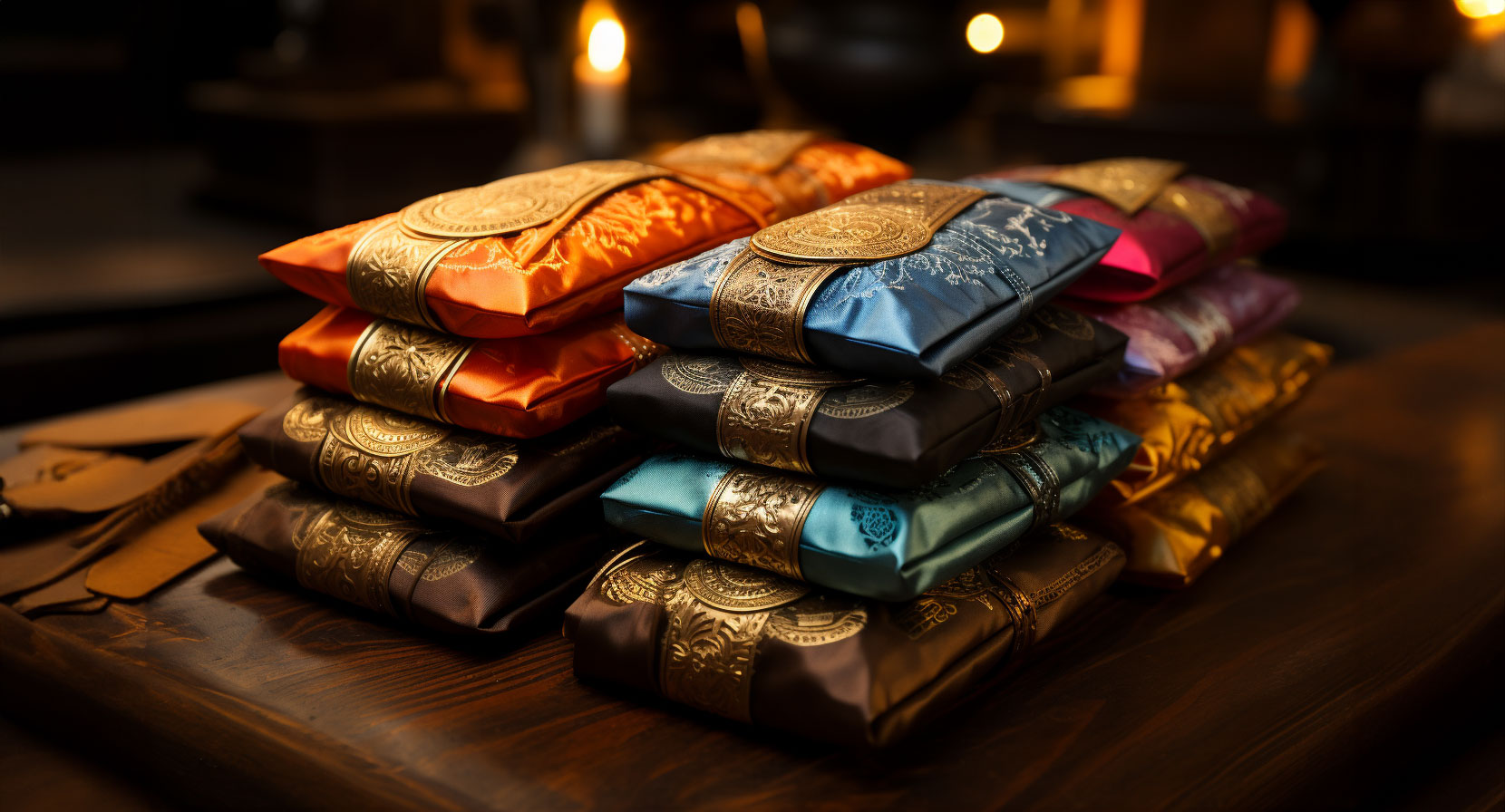
Zawadi ya Heshima, or 'Payment with Respect,' the presentation of Mstatili wa Gawida in a highly decorated silk pouch. This ceremonial gesture, often used in significant financial dealings, symbolizes respect, alliance, or deference. Whether in the black market, between governments, among pirates, or even in paying a bribe, the Zawadi ya Heshima is a powerful symbol of trust and honor, a tradition that transcends mere transaction and speaks to the deeper connections and hierarchies within Southern Mchanga Hasira society.
Value Equivalencies:
- Northern Gold Mzigo "Gawida" ≈ Southern Mizunguko (Mizun)
- 30 Silver Sarafu "Shabara" = 1 Mizunguko (Mizun)
- 120 Copper Sarafu "Chakopa" = 1 Mizunguko (Mizun)
- 1 Siku = 30 Sarafu
- 1 Mstatili wa Gawida = 360 Sarafu
Currencies of The Qāāzami - The Desert Tribes of the Bara Kusini
Harzhim - The Resin Currency of The Qāāzami
Minting Authority:
Harvested and graded by the Mwandishi of the Qāāzami tribes, based on smell, visual inspection, and harvest providence.
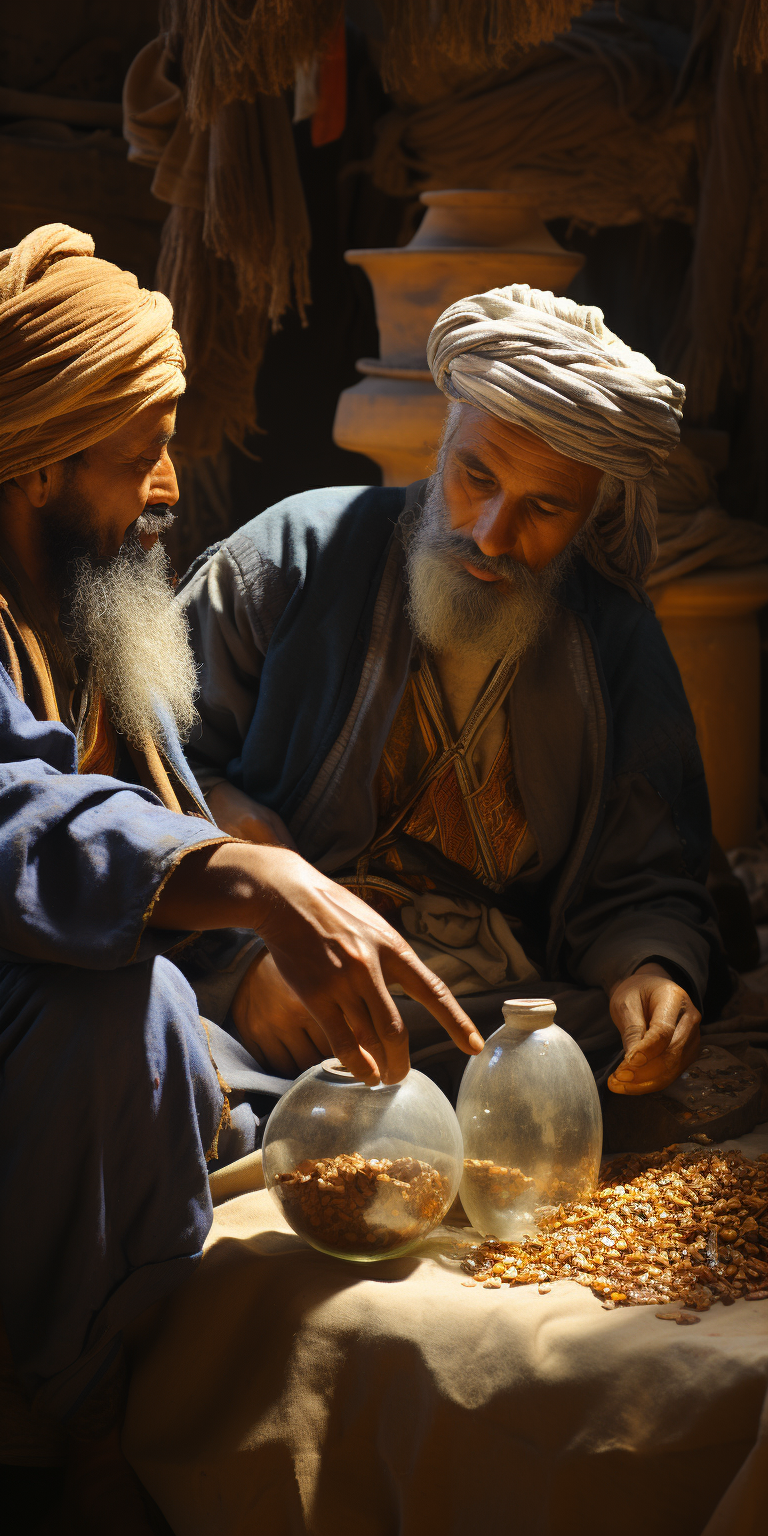
In the arid and mystical lands of the Bara Kusini's desert tribes, currency takes on a form as unique and spiritual as the people themselves. Known as Harzhim in Qāāzana'i Kalima and Jiwe la Ndoto in Kawaida, this resin currency is not only a medium of exchange but a sacred substance, deeply intertwined with the Qāāzami's cultural and spiritual practices.
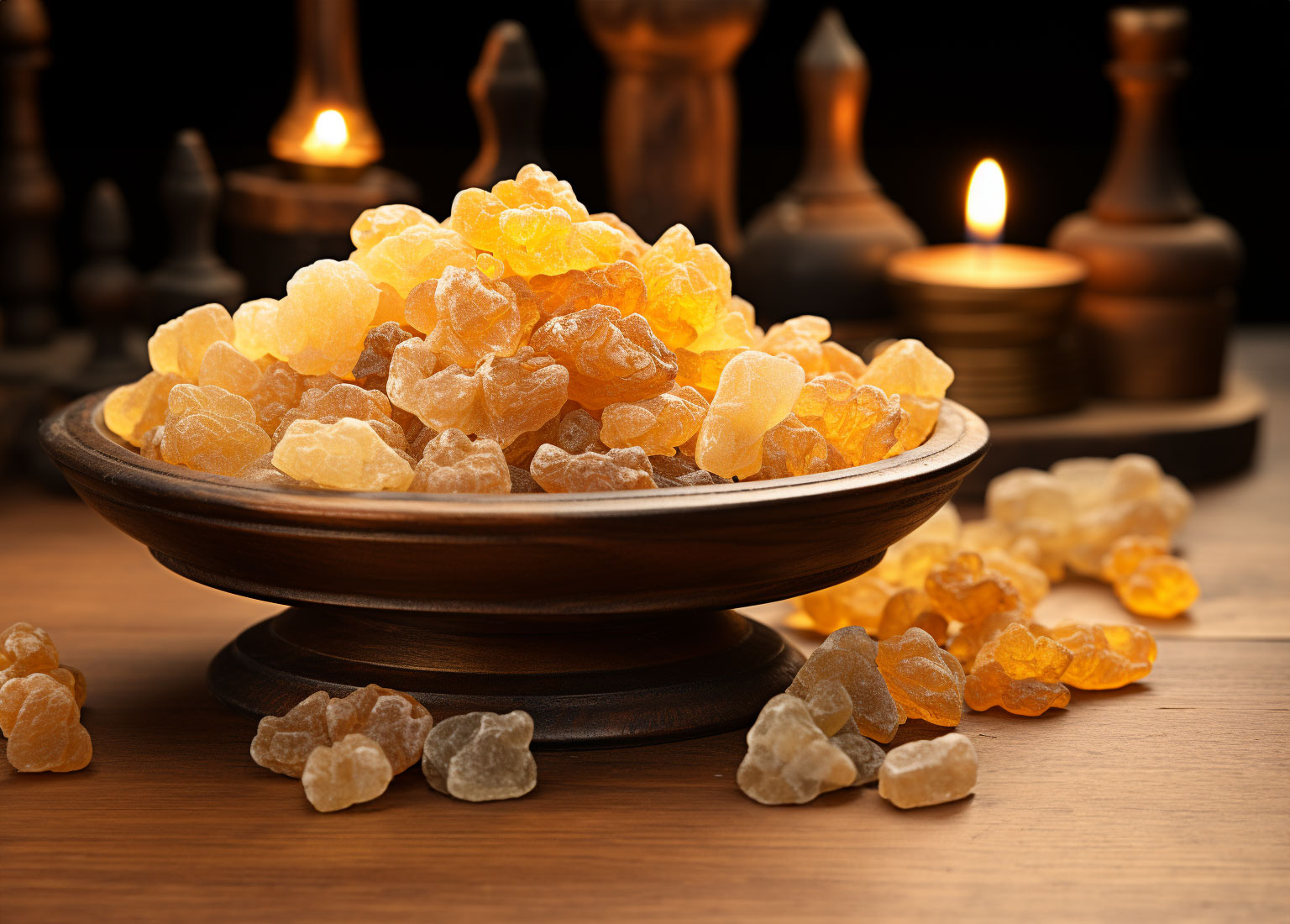 Harzhim is harvested from the Maono Mhosa plant, a source of both sustenance and spiritual insight for the Qāāzami. The resin's value is not fixed; it is graded by the Mwandishi based on various factors, including smell, appearance, age, and harvest providence. Once graded, it is dated, weighed, sealed in waxed parchment, and stamped with its quality, establishing its value in trade.
Harzhim is harvested from the Maono Mhosa plant, a source of both sustenance and spiritual insight for the Qāāzami. The resin's value is not fixed; it is graded by the Mwandishi based on various factors, including smell, appearance, age, and harvest providence. Once graded, it is dated, weighed, sealed in waxed parchment, and stamped with its quality, establishing its value in trade.
The use of Harzhim as currency reflects the Qāāzami's profound connection to their environment and their spiritual beliefs. It is not merely a trade good but a symbol of life, wisdom, and the desert's bounty. The resin's fluctuating value adds to its mystique, making each transaction a dance of negotiation and mutual respect.
In the hands of the Qāāzami, Harzhim is not just currency; it's a way of being. It's a melody of scent and sight, a story told through the hands of harvesters and the eyes of Mwandishi. It's a system that speaks to the heart of a people, living under the watchful gaze of a relentless sun, thriving in a land where tradition and spirituality walk hand in hand.
Everyday Currency:
- Harzhim (Jiwe la Ndoto) - Resin Currency
- Material: Resin from the Maono Mhosa plant
- Value: Fluctuates based on grading factors
- Description: Often used in spiritual practices, this resin currency is graded, dated, and stamped with its quality. It is a symbol of the Qāāzami's cultural heritage and spiritual connection.
Value Equivalencies:
- Harzhim's value is not fixed and is determined by various factors, including its grade, age, and harvest providence. It is often sampled by Mwandishi in the grading process, reflecting a unique blend of practicality and spiritual significance.
![tychodreq_frankincense_resin_displayed_on_an_ornately_decorated_b1929c8b-3913-4a63-a552-046bafbaa36f[1].png](/application/files/5616/9108/5859/tychodreq_frankincense_resin_displayed_on_an_ornately_decorated_b1929c8b-3913-4a63-a552-046bafbaa36f1.png)
![tychodreq_a_stone_table_littered_with_strings_of_medium_sized_t_99b8271a-4a86-4d77-ac6a-12dc30e0cd0d[1].png](http://sayarii.world/application/files/8416/9108/5213/tychodreq_a_stone_table_littered_with_strings_of_medium_sized_t_99b8271a-4a86-4d77-ac6a-12dc30e0cd0d1.png)